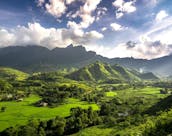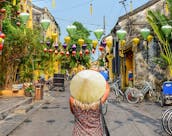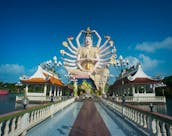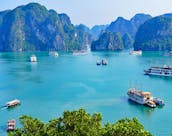Vietnam Awaits: Travel Routes, Hidden Gems & Planning Advice
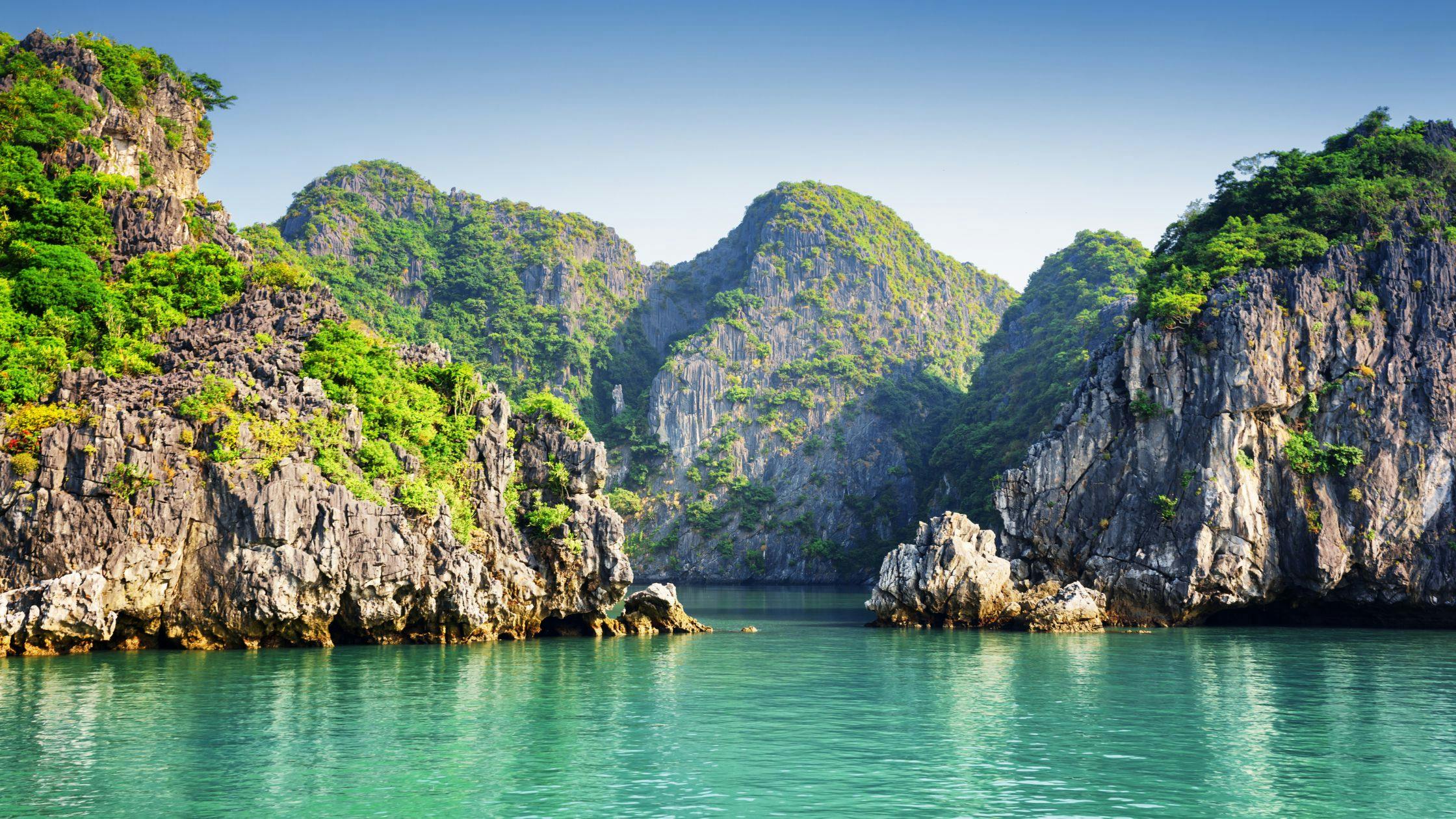
Your Journey Through Timeless Vietnam
A land where ancient temples whisper tales of dynasties and emerald rice fields roll endlessly, Vietnam captures every traveler’s heart. From the limestone cliffs of Ha Long Bay to the lantern-lit streets of Hoi An and the modern pulse of Ho Chi Minh City, Vietnam offers a rich mix of tradition, adventure, and beauty.
This ultimate guide covers where to go, how to plan, best times to visit, top attractions, and insider tips and everything you need to make your Vietnam trip unforgettable. Not sure what to do in Vietnam on your first visit? From mountain treks to coastal cruises, the country offers endless adventures for every kind of traveler.
Vietnam at a Glance
- Capital: Hanoi
- Currency: Vietnamese Dong (VND)
- Language: Vietnamese
- Time Zone: GMT +7
- Best For: Culture Lovers, Foodies, Backpackers, Adventure Seekers
- Visa: E-visa available for most nationalities
Quick Facts: Vietnam’s official language is Vietnamese, though English is widely spoken in tourist cities. The country operates on GMT+7 and uses the Vietnamese Dong (VND) as currency. Most international cards are accepted in cities, while cash is preferred in smaller towns.
Vietnam Key Facts & Planning Guide
Where is Vietnam Located?
Vietnam is a Southeast Asian country bordering China, Laos, and Cambodia, with a stunning coastline along the South China Sea. Its geography ranges from northern mountains and highlands to central coastlines and tropical southern deltas giving every traveler a unique landscape to explore.
Why Visit Vietnam? Top 3 Reasons
Cultural Harmony:
From Hanoi’s old-world charm to the French colonial architecture of Ho Chi Minh City, Vietnam beautifully balances its ancient and modern identities.
Culinary Delights:
Taste the authentic flavors of pho, banh mi, and fresh spring rolls, dishes that define Vietnamese street food culture worldwide.
Natural Wonders:
Cruise through Ha Long Bay, trek the rice terraces of Sapa, or relax on the beaches of Da Nang, Vietnam’s natural beauty is endless.
Best Time to Visit Vietnam: Seasons & Highlights
Vietnam’s weather varies by region, making it a year-round destination, but timing your trip right enhances your experience.
Spring (February–April):
Pleasant temperatures and clear skies make this one of the best times to explore the entire country. It’s also Tet Festival season, Vietnam’s Lunar New Year celebration.
Summer (May–August):
Warm and humid with occasional rains. Great for northern mountain trekking or beach escapes in Da Nang, Nha Trang, and Phu Quoc.
Autumn (September–November):
Cool and dry in most regions, ideal for sightseeing in Hanoi, Ha Long Bay, and Central Vietnam.
Winter (December–January):
Cooler in the north (Hanoi, Sapa) and perfect for exploring the southern regions like Ho Chi Minh City and the Mekong Delta.
Best Time by Interest:
- For Beaches: April to August
- For Trekking: September to November
- For Festivals & Culture: January to April
- For Budget Travel: June and October (off-season)
Getting There & Around Vietnam
How to Get to Vietnam
Vietnam’s major international airports are:
- Noi Bai International Airport (HAN) in Hanoi (North)
- Da Nang International Airport (DAD) in Central Vietnam
- Tan Son Nhat International Airport (SGN) in Ho Chi Minh City (South)
These airports are well connected to Asian, Middle Eastern, and European destinations.
Getting Around Vietnam
Vietnam’s transport network is efficient and affordable.
- Flights: Domestic flights connect major cities quickly.
- Trains: The Reunification Express runs from Hanoi to Ho Chi Minh City, a scenic journey along the coast.
- Buses: Ideal for intercity and local travel, with routes covering even remote areas.
- Scooters & Cycles: Common in towns like Hoi An, fun for short distances.
- Grab App: Use it for safe and easy local transport.
Where to Stay in Vietnam: Top Areas for Travelers
- Hanoi: Stay near the Old Quarter for cultural vibes, cafes, and street markets.
- Ha Long Bay: Choose an overnight cruise or coastal hotel for scenic views.
- Hoi An: Boutique hotels or riverside homestays offer peace and charm.
- Hue: Stay close to the Imperial Citadel for easy sightseeing.
- Ho Chi Minh City: District 1 is perfect for nightlife, restaurants, and accessibility.
- Phu Quoc: Luxury beachfront resorts and villas for a tropical escape.
For newlyweds comparing Vietnam or Thailand for honeymoon couples, Vietnam’s beaches in Phu Quoc, Da Nang, and Nha Trang offer the perfect mix of romance, privacy, and tropical beauty.
Top Things to Do in Vietnam: Attractions & Experiences
If you’re planning your route and wondering which Vietnam tourist places should top your list, here are some must-visit destinations that capture the country’s spirit and charm. Discover more with our complete list of Things to Do in Vietnam.
Must-See Sights:
- Ha Long Bay: A UNESCO World Heritage site of limestone islands and turquoise waters.
- Hoi An Ancient Town: Lantern festivals, tailor shops, and riverside charm.
- Hue Imperial City: The seat of Vietnam’s Nguyen Dynasty, filled with palaces and pagodas.
- Cu Chi Tunnels: Explore underground wartime tunnels near Ho Chi Minh City.
- Sapa Terraces: Trek through rice fields and hill tribe villages.
- Ninh Binh: Called “Ha Long Bay on land,” known for boat rides and karst mountains.
- Phu Quoc Island: White-sand beaches, coral reefs, and relaxed vibes.
- Mekong Delta: Cruise through floating markets and village life.
Recommended Vietnam Itineraries
5-Day Highlights Itinerary: Culture, Scenery & Relaxation
Day 1 – Arrive in Hanoi:
Explore Hanoi’s Old Quarter, Hoan Kiem Lake, and the Temple of Literature. Try street food classics like pho and bun cha at local stalls.
Day 2 – Hanoi Sightseeing:
Visit the Ho Chi Minh Mausoleum, One Pillar Pagoda, and Ethnology Museum. In the evening, watch a traditional Water Puppet Show.
Day 3 – Ha Long Bay Cruise:
Travel to Ha Long Bay (approx. 3–4 hours). Board an overnight cruise through limestone islands, enjoy kayaking, and witness the sunset on deck.
Day 4 – Fly to Hoi An (via Da Nang):
Disembark and fly from Hanoi to Da Nang. Drive to Hoi An, a UNESCO-listed town famous for lantern-lit streets and riverside charm. Evening stroll around the Ancient Town.
Day 5 – Explore Hoi An & Departure:
Discover local markets, tailor shops, and Japanese Covered Bridge. Visit An Bang Beach before your flight home or onward journey.
10-Day Classic Route: The Best of North, Central & South Vietnam
Day 1 – Arrive in Hanoi:
Check into your hotel and explore the Old Quarter. Try Vietnamese coffee and enjoy a cyclo ride through the narrow lanes.
Day 2 – Hanoi City Tour:
Visit historical landmarks: Ho Chi Minh Mausoleum, Tran Quoc Pagoda, and Hoa Lo Prison. Enjoy an evening street food tour.
Day 3 – Ha Long Bay Cruise:
Depart early for Ha Long Bay. Spend the day sailing, kayaking, and exploring hidden caves. Overnight stay on board.
Day 4 – Return & Transfer to Ninh Binh:
Head south to Ninh Binh, often called “Ha Long Bay on land.” Visit Tam Coc for a scenic boat ride among limestone peaks.
Day 5 – Ninh Binh to Da Nang / Hoi An:
Travel back to Hanoi and catch a flight to Da Nang. Transfer to Hoi An and enjoy a peaceful evening by the river.
Day 6 – Hoi An Old Town:
Visit the Japanese Bridge, Tan Ky Old House, and Hoi An Market. Try a local cooking class or cycle to the countryside.
Day 7 – Hoi An to Hue:
Drive along the Hai Van Pass, one of Vietnam’s most scenic coastal routes. Explore the Imperial Citadel and Thien Mu Pagoda in Hue.
Day 8 – Hue to Ho Chi Minh City:
Fly to Ho Chi Minh City. Stroll along Nguyen Hue Walking Street and visit Ben Thanh Market for local souvenirs.
Day 9 – Ho Chi Minh City & Cu Chi Tunnels:
Take a half-day excursion to the Cu Chi Tunnels. In the afternoon, visit Notre-Dame Cathedral and the War Remnants Museum.
Day 10 – Mekong Delta Excursion & Departure:
Explore the Mekong Delta’s floating markets and local villages. Return to Ho Chi Minh City for departure.
Vietnam on a Budget: Cost & Tips
If you’re planning your very first Southeast Asian trip and asking yourself is Vietnam better than Thailand for first-time travellers, Vietnam’s affordability, connectivity, and friendly vibe make it an ideal start.
Average Daily Budget:
- Backpackers: $40–60/day (hostels, local eateries, buses)
- Mid-range Travelers: $80–120/day (3-star hotels, domestic flights, guided tours)
- Luxury Travelers: $200+/day (4–5-star stays, private transfers, fine dining)
Money-Saving Tips:
- Use Grab for affordable city transport.
- Eat at street food stalls for authentic and cheap meals.
- Buy a local SIM for data and maps.
- Stay in guesthouses or homestays for local experiences.
- Book your Vietnam tour packages early for better pricing.
Essential Vietnam Travel Tips
Is Vietnam Safe?
Yes, Vietnam is one of Asia’s safest travel destinations. Petty theft can occur in crowded areas, but violent crime is rare.
Local Etiquette:
- Dress modestly at temples and religious sites.
- Always remove shoes before entering homes or pagodas.
- Avoid touching someone’s head and it’s considered disrespectful.
- Carry small bills for local markets.
- Learn basic greetings like “Xin Chào” (Hello) and “Cảm Ơn” (Thank You).
What to Pack:
- Lightweight clothes and a rain jacket.
- Comfortable shoes for walking or hiking.
- Sunscreen, hat, and insect repellent.
- Travel adaptor (Type A, C, or D).
- Power bank and reusable water bottle.
Final Thoughts
Vietnam is a country that blends soul-stirring landscapes with warm hospitality and deep-rooted culture. From the vibrant cities to the tranquil countryside, every journey here tells a story. Whether it’s sipping coffee by Hanoi’s Hoan Kiem Lake or sailing across Ha Long Bay, each experience leaves lasting memories. Many travelers also wonder why choose Vietnam over Thailand, and the answer lies in its blend of affordable luxury, welcoming locals, and untouched natural beauty that still feels authentic.
Ready to explore Vietnam without the planning stress?
Let Travelfika take care of it all.

